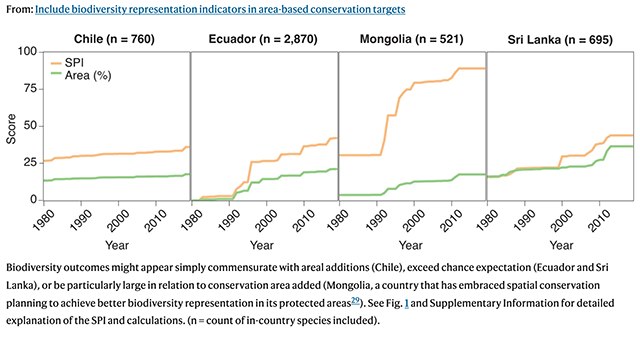

Above: Fig. 2: Example of four countries with differing divergence in protected area coverage and biodiversity outcomes as measured by the country SPI for terrestrial vertebrates.
In Include biodiversity representation indicators in area-based conservation targets, the authors of the new paper in nature ecology & evolution write, “advances in spatial biodiversity science and nationally available data have enabled the development of indicators that report on biodiversity outcomes, account for uneven global biodiversity between countries, and provide direct planning support. We urge their inclusion in the post-2020 global biodiversity framework.
In 2022, parties to the Convention on Biological Diversity (CBD) will assemble in Kunming, China to agree on the post-2020 global biodiversity framework1 (GBF). Addressing threats that contribute to species extinctions and affect their role in ensuring ecosystem integrity underpins the GBF’s overarching Goal A, which stipulates “healthy and resilient populations of all species” and “reduced extinction rates”. Although multiple actions are needed to safeguard biodiversity, establishing targets for protected areas and other effective area-based conservation measures (OECMs) is recognized as a primary mechanism to achieve Goal A.”
Representing individual perspectives that range from conservation policy guidance to biodiversity indicator development, they further share, “We are concerned that measuring coverage of area alone, or of key ‘important’ areas, disregards advances in biodiversity science that have been made since the pre-2010 inception of the previous framework and ignores spatial planning principles known to deliver superior conservation outcomes through adequate representation.”
Read more in the journal nature ecology & evolution.
Author Information: Affiliations
- Department of Ecology and Evolutionary, Yale University, New Haven, CT, USAWalter Jetz, Jennifer McGowan & D. Scott Rinnan
- Center for Biodiversity and Global Change, Yale University, New Haven, CT, USAWalter Jetz, Jennifer McGowan & D. Scott Rinnan
- E.O. Wilson Biodiversity Foundation, Durham, NC, USAWalter Jetz
- The Nature Conservancy, Arlington, VA, USAJennifer McGowan
- School of Biological Sciences, University of Queensland, St Lucia, Queensland, AustraliaHugh P. Possingham
- International Institute for Applied Systems Analysis (IIASA), Laxenburg, AustriaPiero Visconti
- Campaign for Nature, Durango, CO, USABrian O’Donnell
- The Alexander von Humboldt Institute for Research on Biological Resources, Bogotá, DC, ColombiaMaria Cecilia Londoño-Murcia

